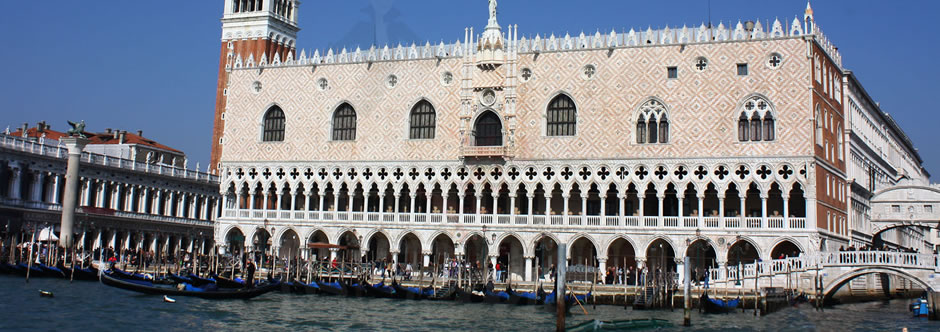
Visit Venice

The Doges Palace is a monumental piece of architecture and perhaps the most important site in Venice. The building was originally founded in the 14th and 15th century with other elements being added over the years. There are three main areas of the structure, the oldest being the closest to St. Mark's Basin (1340), the block facing St. Mark's Square took its present form in 1424 and the part facing the Grand Canal was built between 1483 and 1565.
As early as the 7th century the local affairs of Venice were governed by a Doge or Duke and despite being under the Byzantine Emperor the city was relatively autonomous. From the 10th to 11th century the Doge, his whole entourage, public offices, courtrooms, residential apartments, stables, prison, armory and other civil facilities were moved to the present site of the palace. The "Old Castle" was considered safe, a group of buildings were surrounded by strong walls with thick corner towers. Under Doge Ziani (1172-1178) additions to the structure and renovations were carried out following a destructive fire. In the 14th century the palace needed to be expanded again due to the increased number of participants in government affairs. Doge Franesco Foscari instigated further changes in the 15th century and several fires caused more renovations and construction. In the 17th century the prison was separated from the palace proper and constructed by Antonio Contin across the Bridge of Signs. So prisoners would be sentenced in the palace courtrooms and then walk across the bridge to the prison (or their execution), on their way they would sigh! After the fall of the Venetian Republic in 1797 the city was occupied by the French, the Austrians and finally in 1866 it joined unified Italy. In 1996 the palace became a public museum.
Visitors enter the Palazzo Ducale through the Porta del Frumento through a colonnade. The façade facing the lagoon is the oldest part of the palace there are sculptures on the corners by Filippo Calendari, Antonio Bregno and Matteo Raverti. Porta della Carta, a ceremonial entrance, was decorated by Giovanni and Bartolomeo Bon. Above the entrance are a bust of St. mark and the iconic statue of justice. On the bottom floor, where the kitchens used to be there is now the Museo dell'Opera. The courtyard is home to Sansovino's colossal statues, Neptune and Mars, which guard the Giants' Staircase. From the ground floor courtyard you go up to the first floor loggia and the Doge's Apartments.
In the Doge's Apartments are a number of exquisite rooms each more beautiful than the next. There are frescoes by Giuseppe Salviati and Titian, carved wooden ceilings; marble reliefs by Antonio and Tullio Lombardo; ancient maps; paintings by Andrea Vicentino; Vittore Carpaccio's painting Andante Lion and numerous stunning works of art. The palace has a series of hidden passages ways which connect different rooms like the stairway behind a small door in the Shield Hall which leads to the Philosopher's Room.
Some of the many things not to miss on a visit to the Doge Palace are the arcade statues by Filippo Calendario; the Foscari Arch; the Prisons; paintings by Tintoretto, Veronese and Bella; the Sala del Collegio where you can see the Doge's throne; Tintoretto's ceiling frescoes in the Sala del Senato and Tiepolo's painting of Neptune Bestowing Gifts Upon Venice in the Sala del Consiglio dei Dieci. For a really interesting visit take the Secret Itinerary Tour of the Palazzo Ducale.

